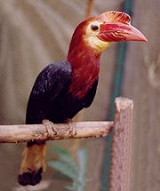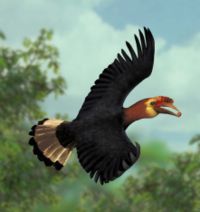
Writhed-billed Hornbill
Encyclopedia
The Walden's Hornbill also known as the Visayan Wrinkled Hornbill, Rufous-headed Hornbill or Writhed-billed Hornbill, is a critically endangered
species of hornbill
living in the rainforests on the islands of Negros and Panay
in the Philippines
. It is closely related to the Writhed Hornbill, but can be recognized by the yellow throat and ocular skin in the male, and the blue throat and ocular skin in the female (both throat and ocular skin are deep orange or red in both sexes of the Writhed Hornbill). Its binomial name commemorates the Scottish ornithologist Viscount Walden
.
 Rainforests with abundant fruit-bearing trees are the natural habitat of these birds. The Rufous-headed Hornbills live in small groups and are noisy. The Rufous-headed Hornbills use natural or carved-out hollows in tree trunks for its nest. As other hornbills, they reproduce very slowly. As lack of appropriate nesting sites is a problem, nest box
Rainforests with abundant fruit-bearing trees are the natural habitat of these birds. The Rufous-headed Hornbills live in small groups and are noisy. The Rufous-headed Hornbills use natural or carved-out hollows in tree trunks for its nest. As other hornbills, they reproduce very slowly. As lack of appropriate nesting sites is a problem, nest box
es are being attached to tree trunks in certain reserves.
and now survives only on Negros and Panay. The total population has been estimated at less than 160, though recent work from the Central Panay Mountain Range suggests 600-700 pairs may remain there. No recent figures are available for Negros, where it may be functionally extinct.
Critically endangered
Version 2010.3 of the IUCN Red List of Threatened Species identified 3744 Critically Endangered species, subspecies and varieties, stocks and subpopulations.Critically Endangered by kingdom:*1993 Animalia*2 Fungi*1745 Plantae*4 Protista-References:...
species of hornbill
Hornbill
Hornbills are a family of bird found in tropical and subtropical Africa, Asia and Melanesia. They are characterized by a long, down-curved bill which is frequently brightly-colored and sometimes has a casque on the upper mandible. Both the common English and the scientific name of the family...
living in the rainforests on the islands of Negros and Panay
Panay Island
Panay is an island in the Philippines located in the western part of the Visayas. Politically, it is divided into five provinces: Aklan, Antique, Capiz, and Iloilo, all in the Western Visayas Region. It is located southeast of the island of Mindoro and northwest of Negros, separated by the...
in the Philippines
Philippines
The Philippines , officially known as the Republic of the Philippines , is a country in Southeast Asia in the western Pacific Ocean. To its north across the Luzon Strait lies Taiwan. West across the South China Sea sits Vietnam...
. It is closely related to the Writhed Hornbill, but can be recognized by the yellow throat and ocular skin in the male, and the blue throat and ocular skin in the female (both throat and ocular skin are deep orange or red in both sexes of the Writhed Hornbill). Its binomial name commemorates the Scottish ornithologist Viscount Walden
Arthur Hay, 9th Marquess of Tweeddale
Colonel Arthur Hay, 9th Marquess of Tweeddale , known before 1862 as Lord Arthur Hay and between 1862 and 1876 as Viscount Walden, was a Scottish soldier and ornithologist. He was born at Yester, Gifford, East Lothian. He served as a soldier in India and the Crimea. He succeeded his father to the...
.
Habitat and behaviour

Nest box
A nest box, also spelled nestbox is a man-made box provided for animals to nest in. Nest boxes are most frequently utilized for wild and domesticated birds, in which case they are also called birdhouses, but some mammalian species may also use them. Birdhouses are the most common types of nest...
es are being attached to tree trunks in certain reserves.
Status
This is a critically endangered species. Rufous-headed Hornbills reproduce very slowly and thus are unable to survive high hunting pressures coupled with heavy logging of the rainforests. It is presumed extinct on GuimarasGuimaras
Guimaras is an island province of the Philippines located in the Western Visayas region. Among the smallest provinces, its capital is Jordan. The island is located in the Panay Gulf, between the islands of Panay and Negros...
and now survives only on Negros and Panay. The total population has been estimated at less than 160, though recent work from the Central Panay Mountain Range suggests 600-700 pairs may remain there. No recent figures are available for Negros, where it may be functionally extinct.

